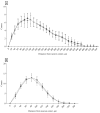Early Life Vitamin C Deficiency Does Not Alter Morphology of Hippocampal CA1 Pyramidal Neurons or Markers of Synaptic Plasticity in a Guinea Pig Model
- PMID: 29890692
- PMCID: PMC6024653
- DOI: 10.3390/nu10060749
Early Life Vitamin C Deficiency Does Not Alter Morphology of Hippocampal CA1 Pyramidal Neurons or Markers of Synaptic Plasticity in a Guinea Pig Model
Abstract
Approximately 15% of the Western world population, including pregnant women and their children, is characterized as vitamin C (vitC) deficient. In guinea pigs, early life vitC deficiency causes spatial memory deficits, decreased hippocampal volume and neuron numbers, in otherwise clinically healthy animals. We hypothesized that vitC deficiency leads to decreased brain-derived neurotrophic factor and synaptic plasticity markers in selected brain areas (frontal cortex, hippocampus and striatum) and cause morphological changes in cornu ammonis 1 pyramidal neurons of the hippocampus either through a direct effect or indirectly by increased oxidative stress. Fifty-seven female guinea pigs were allocated to three groups receiving either 1390, 100 or 0⁻50 mg vitC/kg feed for 11 weeks. Dietary vitC levels were reflected in the plasma, cortical and adrenal gland levels, however, redox imbalance was only present in the adrenal glands allowing for the investigation of a direct influence of vitC deficiency on the chosen parameters in the brain. Synaptic plasticity markers were not affected in the investigated brain areas and no differences in isolated pyramidal neuron morphology was recorded. Based on our findings, it appears that vitC deficiency may primarily elicit impaired neuronal function through increased levels of oxidative stress.
Keywords: cavia porcellus; neuronal morphology; synaptic plasticity; vitamin C deficiency.
Conflict of interest statement
The authors declare no conflict of interest.
Figures






Similar articles
-
Vitamin C Deficiency in the Young Brain-Findings from Experimental Animal Models.Nutrients. 2021 May 15;13(5):1685. doi: 10.3390/nu13051685. Nutrients. 2021. PMID: 34063417 Free PMC article. Review.
-
Maternal vitamin C deficiency does not reduce hippocampal volume and β-tubulin III intensity in prenatal Guinea pigs.Nutr Res. 2016 Jul;36(7):696-702. doi: 10.1016/j.nutres.2016.03.004. Epub 2016 Mar 6. Nutr Res. 2016. PMID: 27333961
-
Distribution of vitamin C is tissue specific with early saturation of the brain and adrenal glands following differential oral dose regimens in guinea pigs.Br J Nutr. 2015 May 28;113(10):1539-49. doi: 10.1017/S0007114515000690. Epub 2015 Apr 13. Br J Nutr. 2015. PMID: 25865869
-
Spatial Memory Dysfunction Induced by Vitamin C Deficiency Is Associated with Changes in Monoaminergic Neurotransmitters and Aberrant Synapse Formation.Antioxidants (Basel). 2018 Jun 29;7(7):82. doi: 10.3390/antiox7070082. Antioxidants (Basel). 2018. PMID: 29966224 Free PMC article.
-
The Pharmacokinetics of Vitamin C.Nutrients. 2019 Oct 9;11(10):2412. doi: 10.3390/nu11102412. Nutrients. 2019. PMID: 31601028 Free PMC article. Review.
Cited by
-
HDAC2 hyperexpression alters hippocampal neuronal transcription and microglial activity in neuroinflammation-induced cognitive dysfunction.J Neuroinflammation. 2019 Dec 3;16(1):249. doi: 10.1186/s12974-019-1640-z. J Neuroinflammation. 2019. PMID: 31796106 Free PMC article.
-
Vitamin C Deficiency Exacerbates Dysfunction of Atherosclerotic Coronary Arteries in Guinea Pigs Fed a High-Fat Diet.Antioxidants (Basel). 2022 Nov 11;11(11):2226. doi: 10.3390/antiox11112226. Antioxidants (Basel). 2022. PMID: 36421412 Free PMC article.
-
Nicotine suppresses crystalline silica-induced astrocyte activation and neuronal death by inhibiting NF-κB in the mouse hippocampus.CNS Neurosci Ther. 2024 Apr;30(4):e14508. doi: 10.1111/cns.14508. Epub 2023 Oct 21. CNS Neurosci Ther. 2024. PMID: 37864452 Free PMC article.
-
Vitamin C Deficiency in the Young Brain-Findings from Experimental Animal Models.Nutrients. 2021 May 15;13(5):1685. doi: 10.3390/nu13051685. Nutrients. 2021. PMID: 34063417 Free PMC article. Review.
-
Role of vitamin C and SVCT2 in neurogenesis.Front Neurosci. 2023 Jun 22;17:1155758. doi: 10.3389/fnins.2023.1155758. eCollection 2023. Front Neurosci. 2023. PMID: 37424994 Free PMC article. Review.
References
-
- Tolsa C.B., Zimine S., Warfield S.K., Freschi M., Rossignol A.S., Lazeyras F., Hanquinet S., Pfizenmaier M., Hüppi P.S. Early alteration of structural and functional brain development in premature infants born with intrauterine growth restriction. Pediatr. Res. 2004;56:132–138. doi: 10.1203/01.PDR.0000128983.54614.7E. - DOI - PubMed
MeSH terms
Substances
LinkOut - more resources
Full Text Sources
Other Literature Sources
Miscellaneous

